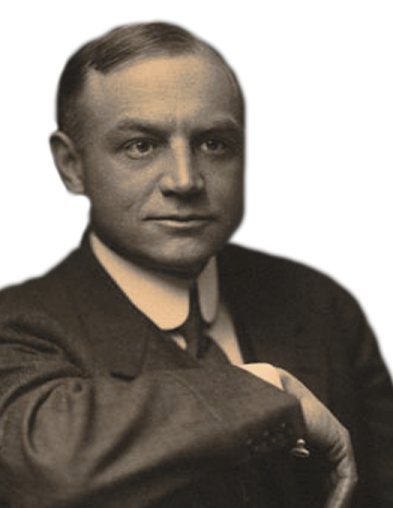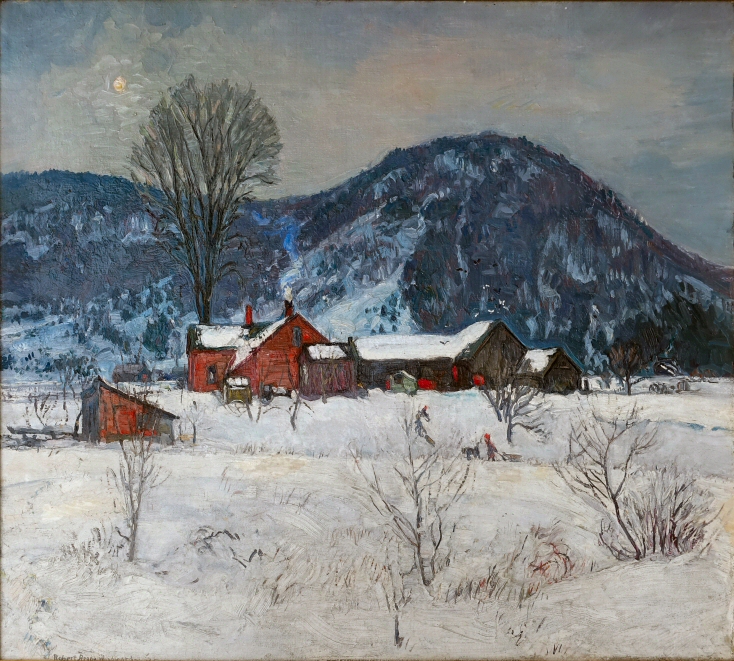George DuPont Pratt
Industrailist / Philanthropist


 George DuPont Pratt (Photo © Pratt Libraries)
George DuPont Pratt (Photo © Pratt Libraries)
A graduate of Amherst College, Pratt had quite the
reputation for being an outstanding athlete as the
captain, quarterback and kicker of the fottball team.
George DuPont Pratt purchased New England Winter from an exhibition at the Deerfield Academy in June of 1932. Woodward notes in his artwork diary, the painting was of the same farm under Purinton Hill he had painted years before in 1925 noting, however, the composition being slightly different, he named Under the Hill.
Pratt, the son of a famous industrialist, has a number of similarities with other famous owners of Woodward's paintings, such as, Adeline Havemeyer Frelinghuysen who was the daughter of sugar magnate Henry Havemeyer. Like Pratt, she, was never as famous or renown as her father would be very involved in preservation and philanthropy. Then you have Josephine Everett and her husband Henry, both children of famous politicians and industrialist, were heavily involved in public transportation like Pratt.
Painting Diary Entry for New England Winter:
"Painted prior to 1928.
A painting of Victor Peltier's house and elm with Purinton Hill in background, the second canvas I made
of the same subject. The first one called Under the Hill, 25 x 30, was bought by Eugenia B. Frothingham
from my Lyman exhibition. This second one of the same subject and slightly different composition was
bought by the oil magnate, Mr. George D. Pratt of Glen Cove, Long Island, N.Y. from my exhibition at
Deerfield Academy in 1932. Since his death it is now owned by Mrs. Pratt?"

 New England Winter, c. 1928, 30" x 40"
New England Winter, c. 1928, 30" x 40"
This is the only image we have of New England Winter. It is from a 1929
Springfield Sunday Union and Republican newspaper dated September
8th, covering that year's annual Stockbridge Art Association Show. It
cites this canvas as having won a "prize in painting" for the event.

 Under the Hill, c. 1925, 27" x 30"
Under the Hill, c. 1925, 27" x 30"
This painting is the other referenced in RSW's diary entry.
It was made prior to New England Winter, still, the two
canvases are very different in perspective, this one
being much more square with the other rectangular.

 Cover of the BSA Handbook from the 1930's
Cover of the BSA Handbook from the 1930's
George Dupont Pratt (1869 - 1935) was the son of Charles Pratt. Pratt was born in Brooklyn New York in 1869. The son of Charles Pratt who was a pioneer in the use of petroleum, in the form of refined kerosene, as a replacement for whale oil most commonly used for lighting lamps since the 16th century. The Charles Pratt Company after seven years of existence joined John D. Rockefeller's Standard Oil Company in 1874.
George Pratt attended Amherst College in Western Massachusetts graduating in 1893. An accomplished athlete he was a member of the track team when it won an NEIAA championship in 1890 and he personally set an NEIAA record in a bicycle race in 1892. He was also the captain and quarterback of the Amherst College football team. In 1897, he married Helen Deming Sherman, great-granddaughter of Roger Sherman from Connecticut, the only founding father to sign all four great documents (the Continental Association, the Declaration of Independence, the articles of Confederation, and the Constitution). He later married Vera Derbyshire Amherst Hale in 1926.
George Pratt worked for the Long Island Rail Road and as a trustee on the Standard Oil Trust, but
it was his philanthropic work that he was best known. He helped create the Boy Scouts of America and served as
the organization's treasurer. He was also New York Conservation Commissioner for six years. He served as a
trustee for the American Museum of Natural History, Metropolitan Museum of Art and Amherst College, as well as,
President of American Forestry Association, for which he also served as editor for the American Forestry Journal.
He was also helped run the Pratt Institute, a private, nonsectarian, non-profit institution of higher learning
located in the Clinton Hill neighborhood of Brooklyn, New York, founded by his father Charles.
Pratt
was also equally known for his beautiful Long Island estate, Killenworth...

 Kellenworth Estate Postcard, year unknown
Kellenworth Estate Postcard, year unknown
LG.png?url=photos/GeorgePratt/pratt_killenworth_terrace_garden(1918)LG.png)
 An image if the estate's sunken garden, 1918
An image if the estate's sunken garden, 1918
From the Wikipedia page regarding Glen Cove, NY
"The vistas afforded of Long Island Sound from the town's rolling hills attracted late 19th-century wealthy industrial barons, including Charles Pratt and his sons, as well as J. P. Morgan, and F. W. Woolworth. They built large private estates along the island's North Shore. This expanse of settled wealth was part of what would become known in the 1920s as the Gold Coast of Nassau County. Part of the Morgan property was donated to the city and is now operated as Morgan Park and Beach."

 Mr. Pratt from what we believe is a
Mr. Pratt from what we believe is a
publication issued by Amherst College.
given the caption cites the year he
graduated the school. He is clearly
older than the picture above...
The building of these large private estates coincided with the extension of the Long Island Railroad to the village of Glen Cove, of which Pratt was surely involved in orchestrating. After his death in 1935, his second wife Vera sold the estate to the Soviet government for use as a consulate and residence of their diplomatic attaches to the United Nations. The estate remains to this day as the consulate for the Russian Federation. At the height of the cold war novelist, Nelson De Mille featured the estate in two of his best selling novels-The Talbot Odessy and The Gold Coast.
It was purchased from Woodward's 1932 exhibit in the brand new dormitory on the Deerfield Academy's campus. This
exhibit was set to run from June 6, 1932, to the 20th. Because it was after the school's graduation, we believe the event was
for the many alumni that would be visiting for reunions and school business before administrators break for summer vacation.
We have yet to be able to confirm if Pratt was a graduate of the academy or in the area with friends who were. We will continue
to enquire.
The painting New England Winter was recently
found to be as celebrated as any of Woodward's other canvases; it exhibited at a number of, either the artist favorite events,
or his biggest ones, such as his first showings at Smith, Mount Holyoke, and Amherst colleges, as well as schools he has strong
connections to, like, Williston and Deerfield; there is also a two year gap where there is no record of it exhibiting suggesting
it either hung some place special to him on loan or it was one of his many paintings to tour with the American Federation of Art
traveling exhibits blanketing the country. This gap also coincides with the timing just after Stockbridge and its unnamed prize
which would make sense considering the import of that show. We know it was not the TOP prize, but neither article gets into
specifics. It seems very fitting the Mr. Pratt would come to own it, in fact, it was who Pratt is that Woodward could not
say no. After all, he always sought the right home for his favorite paintings. This is important to keep in mind, just because
a painting exhibits for years before selling is not an indication of its import. Actually, it is quite the opposite.
BCM, June, 18, 2025
